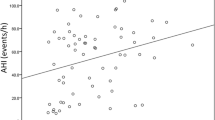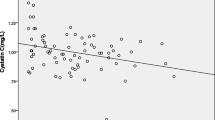Abstracts
Purpose
Serum cystatin C is a promising new biomarker of glomerular filtration rate and cardiovascular events, but few studies focused on serum cystatin C levels in obstructive sleep apnea (OSA) patients. The aim of our study was to evaluate the association between serum cystatin C and OSA in younger men (≤40 years old of age) without complications.
Methods
We prospectively recruited consecutive participants without comorbidities who underwent polysomnography. Fasting blood samples were obtained from all subjects for biological profile measurements. Statistical analysis was used to evaluate the relationship between serum cystatin C and other parameters.
Results
The population consisted of 98 subjects (mean age = 32.5 years, mean body mass index = 27.93 kg/m2) that were divided according to polysomnographic finding into control group (n = 23), mild (n = 15), moderate (n = 24), and severe (n = 36) OSA group. Compared with the control group, patients with severe OSA were significantly heavier (body mass index, 29.69 ± 3.81 vs. 26.42 ± 3.10) and presented significantly higher levels of high sensitive C-reactive protein (hsCRP) (1.10 ± 0.28 vs. 0.88 ± 0.20 mg/l) and serum cystatin C (0.87 ± 0.12 vs. 0.74 ± 0.10 mg/l) (p < 0.05 for all comparisons). Cystatin C was correlated with Apnea Hypopnea Index (AHI), Oxygen Desaturation Index, hsCRP, creatinine, and estimated glomerular filtration rate (r = 0.319, 0.279, 0.321, 0.233, −0.241, p = 0.001, 0.005, 0.001, 0.021, 0.017, respectively). After adjustment for confounding factors, AHI was significantly and positively associated with serum cystatin C levels (β = 0.284, p = 0.007).
Conclusions
Our finding indicated that serum cystatin C was associated with the severity of OSA in younger men. Further study is needed to find out whether OSA patients with increased serum cystatin C levels are prone to subclinical cardiovascular and renal diseases.

Similar content being viewed by others
Abbreviations
- AHI:
-
Apnea Hypopnea Index
- BMI:
-
Body mass index
- DBP:
-
Diastolic blood pressure
- HDL-C:
-
High-density lipoprotein-cholesterol
- hsCRP:
-
High sensitive C-reactive protein
- LDL-C:
-
Low-density lipoprotein-cholesterol
- Mini SaO2 :
-
Minimal O2 saturation
- ODI:
-
Oxygen Desaturation Index
- SBP:
-
Systolic blood pressure
- TC:
-
Total cholesterol
- TG:
-
Triglycerides
- TST:
-
The percentage of total sleep time spent with SaO2 <90 %
References
Young T, Palta M, Dempsey J, Skatrud J, Weber S, Badr S (1993) The occurrence of sleep-disordered breathing among middle-aged adults. N Engl J Med 328:1230–1235
Deegan PC, McNicholas WT (1995) Pathophysiology of obstructive sleep apnoea. Eur Respir J 8:1161–1178
Young T, Peppard P (2000) Sleep-disordered breathing and cardiovascular disease: epidemiologic evidence for a relationship. Sleep 23(Suppl 4):S122–S126
Punjabi NM, Newman AB, Young TB, Resnick HE, Sanders MH (2008) Sleep-disordered breathing and cardiovascular disease: an outcome-based definition of hypopneas. Am J Respir Crit Care Med 177:1150–1155
Martinez D, Klein C, Rahmeier L, da Silva RP, Fiori CZ, Cassol CM, Goncalves SC, Bos AJ (2011) Sleep apnea is a stronger predictor for coronary heart disease than traditional risk factors. Sleep Breath. doi:10.1007/s11325-011-0559-0
Iseki K, Tohyama K, Matsumoto T, Nakamura H (2008) High prevalence of chronic kidney disease among patients with sleep related breathing disorder (SRBD). Hypertens Res 31:249–255
Casey KR (2010) Sleep disorders in chronic kidney disease. Sleep Med 11:231–232
Go AS, Chertow GM, Fan D, McCulloch CE, Hsu CY (2004) Chronic kidney disease and the risks of death, cardiovascular events, and hospitalization. N Engl J Med 351:1296–1305
Sarnak MJ, Levey AS, Schoolwerth AC, Coresh J, Culleton B, Hamm LL, McCullough PA, Kasiske BL, Kelepouris E, Klag MJ, Parfrey P, Pfeffer M, Raij L, Spinosa DJ, Wilson PW (2003) Kidney disease as a risk factor for development of cardiovascular disease: a statement from the American Heart Association Councils on Kidney in Cardiovascular Disease, High Blood Pressure Research, Clinical Cardiology, and Epidemiology and Prevention. Circulation 108:2154–2169
Dharnidharka VR, Kwon C, Stevens G (2002) Serum cystatin C is superior to serum creatinine as a marker of kidney function: a meta-analysis. Am J Kidney Dis 40:221–226
Shlipak MG, Sarnak MJ, Katz R, Fried LF, Seliger SL, Newman AB, Siscovick DS, Stehman-Breen C (2005) Cystatin C and the risk of death and cardiovascular events among elderly persons. N Engl J Med 352:2049–2060
Ix JH, Shlipak MG, Chertow GM, Whooley MA (2007) Association of cystatin C with mortality, cardiovascular events, and incident heart failure among persons with coronary heart disease: data from the Heart and Soul Study. Circulation 115:173–179
Can M, Acikgoz S, Mungan G, Bayraktaroglu T, Kocak E, Guven B, Demirtas S (2006) Serum cardiovascular risk factors in obstructive sleep apnea. Chest 129:233–237
Shamsuzzaman AS, Winnicki M, Lanfranchi P, Wolk R, Kara T, Accurso V, Somers VK (2002) Elevated C-reactive protein in patients with obstructive sleep apnea. Circulation 105:2462–2464
Villa MP, Ianniello F, Tocci G, Evangelisti M, Miano S, Ferrucci A, Ciavarella GM, Volpe M (2011) Early cardiac abnormalities and increased C-reactive protein levels in a cohort of children with sleep disordered breathing. Sleep Breath. doi:10.1007/s11325-010-0462-0
Lee M, Saver JL, Huang WH, Chow J, Chang KH, Ovbiagele B (2010) Impact of elevated cystatin C level on cardiovascular disease risk in predominantly high cardiovascular risk populations: a meta-analysis. Circ Cardiovasc Qual Outcomes 3:675–683
Levey AS, Bosch JP, Lewis JB, Greene T, Rogers N, Roth D (1999) A more accurate method to estimate glomerular filtration rate from serum creatinine: a new prediction equation. Modification of diet in Renal Disease Study Group. Ann Intern Med 130:461–470
Schulz H (2007) Phasic or transient? Comment on the terminology of the AASM manual for the scoring of sleep and associated events. J Clin Sleep Med 3:752
Grubb A, Nyman U, Bjork J, Lindstrom V, Rippe B, Sterner G, Christensson A (2005) Simple cystatin C-based prediction equations for glomerular filtration rate compared with the modification of diet in renal disease prediction equation for adults and the Schwartz and the Counahan-Barratt prediction equations for children. Clin Chem 51:1420–1431
Laterza OF, Price CP, Scott MG (2002) Cystatin C: an improved estimator of glomerular filtration rate? Clin Chem 48:699–707
Pucci L, Triscornia S, Lucchesi D, Fotino C, Pellegrini G, Pardini E, Miccoli R, Del Prato S, Penno G (2007) Cystatin C and estimates of renal function: searching for a better measure of kidney function in diabetic patients. Clin Chem 53:480–488
Watanabe S, Okura T, Liu J, Miyoshi K, Fukuoka T, Hiwada K, Higaki J (2003) Serum cystatin C level is a marker of end-organ damage in patients with essential hypertension. Hypertens Res 26:895–899
Donahue RP, Stranges S, Rejman K, Rafalson LB, Dmochowski J, Trevisan M (2007) Elevated cystatin C concentration and progression to pre-diabetes: the Western New York Study. Diabetes Care 30:1724–1729
Kestenbaum B, Rudser KD, de Boer IH, Peralta CA, Fried LF, Shlipak MG, Palmas W, Stehman-Breen C, Siscovick DS (2008) Differences in kidney function and incident hypertension: the multi-ethnic study of atherosclerosis. Ann Intern Med 148:501–508
Parikh NI, Hwang SJ, Yang Q, Larson MG, Guo CY, Robins SJ, Sutherland P, Benjamin EJ, Levy D, Fox CS (2008) Clinical correlates and heritability of cystatin C (from the Framingham Offspring Study). Am J Cardiol 102:1194–1198
Li Y, Chongsuvivatwong V, Geater A, Liu A (2008) Are biomarker levels a good follow-up tool for evaluating obstructive sleep apnea syndrome treatments? Respiration 76:317–323
Steiropoulos P, Tsara V, Nena E, Fitili C, Kataropoulou M, Froudarakis M, Christaki P, Bouros D (2007) Effect of continuous positive airway pressure treatment on serum cardiovascular risk factors in patients with obstructive sleep apnea–hypopnea syndrome. Chest 132:843–851
Shlipak MG, Katz R, Cushman M, Sarnak MJ, Stehman-Breen C, Psaty BM, Siscovick D, Tracy RP, Newman A, Fried L (2005) Cystatin-C and inflammatory markers in the ambulatory elderly. Am J Med 118:1416
Knight EL, Verhave JC, Spiegelman D, Hillege HL, de Zeeuw D, Curhan GC, de Jong PE (2004) Factors influencing serum cystatin C levels other than renal function and the impact on renal function measurement. Kidney Int 65:1416–1421
Kato K, Takata Y, Usui Y, Shiina K, Asano K, Hashimura Y, Saruhara H, Nishihata Y, Tomiyama H, Yamashina A (2011) Severe obstructive sleep apnea increases cystatin C in clinically latent renal dysfunction. Respir Med 105:643–649
Sim JJ, Rasgon SA, Kujubu DA, Kumar VA, Liu IL, Shi JM, Pham TT, Derose SF (2009) Sleep apnea in early and advanced chronic kidney disease: Kaiser Permanente Southern California cohort. Chest 135:710–716
Denton KM, Shweta A, Anderson WP (2002) Preglomerular and postglomerular resistance responses to different levels of sympathetic activation by hypoxia. J Am Soc Nephrol 13:27–34
Faulx MD, Storfer-Isser A, Kirchner HL, Jenny NS, Tracy RP, Redline S (2007) Obstructive sleep apnea is associated with increased urinary albumin excretion. Sleep 30:923–929
Garg AX, Kiberd BA, Clark WF, Haynes RB, Clase CM (2002) Albuminuria and renal insufficiency prevalence guides population screening: results from the NHANES III. Kidney Int 61:2165–2175
Schuck O, Teplan V, Stollova M, Skibova J (2004) Estimation of glomerular filtration rate in obese patients with chronic renal impairment based on serum cystatin C levels. Clin Nephrol 62:92–96
Acknowledgments
This work was supported by grant C07100008 for Natural Science Foundation from Fujian Province of China. The authors acknowledge the help by Bing Yang for blood analysis.
Conflict of interest
The authors declare that they have no conflict of interest.
Author information
Authors and Affiliations
Corresponding author
Rights and permissions
About this article
Cite this article
Zhang, XB., Lin, QC., Deng, CS. et al. Elevated serum cystatin C in severe OSA younger men without complications. Sleep Breath 17, 235–241 (2013). https://doi.org/10.1007/s11325-012-0678-2
Received:
Revised:
Accepted:
Published:
Issue Date:
DOI: https://doi.org/10.1007/s11325-012-0678-2




